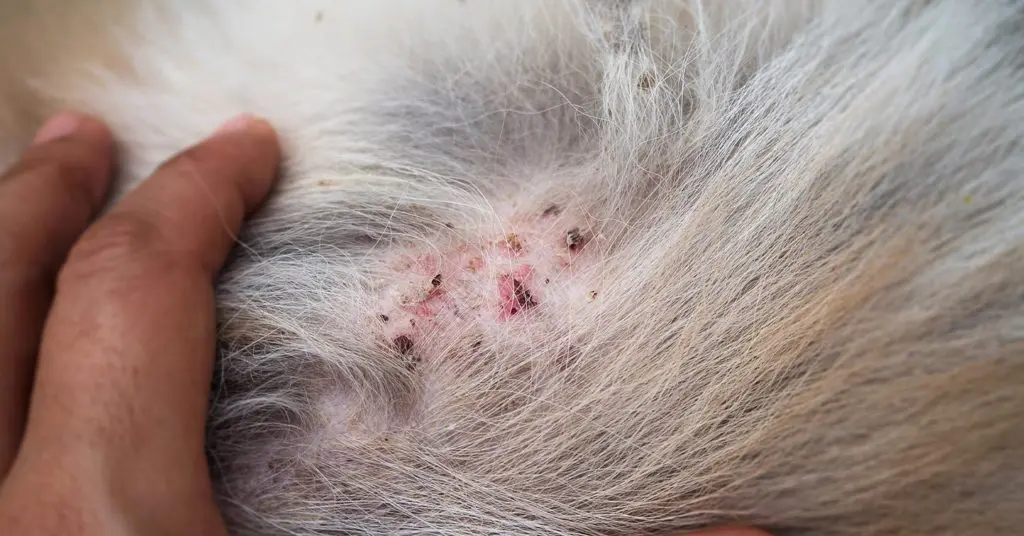Dogs are our loyal companions and we want to keep them healthy and happy. One common issue that dog owners may face is crusty scabs on their dog’s skin. These scabs can be caused by a variety of reasons, such as allergies, infections, or even skin cancer. If left untreated, they can cause discomfort and pain for your furry friend. Therefore, it’s crucial to address them as soon as possible.
Step 1: Identify the Cause of the Scabs
Before treating the scabs, it’s essential to identify the underlying cause. Common causes of crusty scabs include allergies, infections, parasites, and skin cancer. Vets can help diagnose the cause of the scabs through physical examination, skin scrapings, blood tests, or skin biopsies.
Step 2: Clean the Affected Area
Once the cause of the scabs is identified, it’s time to clean the affected area. Use a gentle pet-friendly shampoo to clean the scabbed area thoroughly. Avoid using harsh soaps or chemicals that can irritate your dog’s skin.
Step 3: Apply Topical Treatments
After cleaning the affected area, apply topical treatments as recommended by your vet. Topical treatments can include antibiotics, anti-fungal creams, or anti-inflammatory ointments. These treatments help to reduce inflammation, kill bacteria or fungi, and promote healing.
Step 4: Give Your Dog Proper Nutrition
Nutrition plays a vital role in maintaining your dog’s skin health. Ensure that your dog is getting a well-balanced diet with essential nutrients such as vitamins, minerals, and fatty acids. Consult with your vet to determine the appropriate diet for your furry friend.
Step 5: Monitor Your Dog’s Progress
Monitor your dog’s progress closely and make sure that the scabs are healing. If the scabs do not improve or if your dog is experiencing severe discomfort, it’s time to consult your vet again. They may recommend further treatments such as oral medications or surgery.
What Other Symptoms might Appear Alongside Crusty Scabs?
Crusty scabs on a dog’s skin can be a sign of an underlying health condition, and it’s crucial to be aware of any other symptoms that may appear alongside them. The symptoms may vary depending on the cause of the scabs, but here are some common symptoms that may accompany crusty scabs:
Itching and scratching: Dogs with crusty scabs may experience intense itching, which can cause them to scratch or lick the affected area excessively.
Redness and inflammation: Inflamed and red skin may be present around the scabs, indicating an underlying infection or allergic reaction.
Hair loss: If the scabs are located in areas where the hair is thin, such as the ears or paws, hair loss may be present.
Bad Odor: If the scabs are caused by a bacterial or fungal infection, a bad odor may emanate from the affected area.
Changes in Behavior: Dogs in discomfort may exhibit changes in behavior such as lethargy, loss of appetite, or aggression.
Frequently Asked Questions
Q: What are crusty scabs in dogs?
A: Crusty scabs are raised areas on a dog’s skin that can be caused by various factors, including allergies, infections, parasites, or skin cancer. These scabs can be painful and uncomfortable for your furry friend.
Q: What are the symptoms of crusty scabs in dogs?
A: Common symptoms of crusty scabs in dogs include itching, redness, inflammation, hair loss, bad odor, and changes in behavior.
Q: How are crusty scabs diagnosed in dogs?
A: Diagnosis of crusty scabs in dogs involves a physical examination by a veterinarian, skin scrapings, blood tests, or skin biopsies.
Q: How are crusty scabs treated in dogs?
A: Treatment for crusty scabs in dogs depends on the underlying cause. It may involve cleaning the affected area, applying topical treatments, providing proper nutrition, or administering oral medications or surgery in severe cases.
Q: Can crusty scabs in dogs be prevented?
A: Preventing crusty scabs in dogs involves maintaining good hygiene, providing proper nutrition, regular grooming, and avoiding exposure to allergens and parasites.
In Conclusion
Crusty scabs can be a source of discomfort for your furry friend, and it’s crucial to address them as soon as possible. Identifying the underlying cause, cleaning the affected area, applying topical treatments, providing proper nutrition, and monitoring your dog’s progress are crucial steps in treating your dog’s crusty scabs. By following these steps, you can help your furry friend feel comfortable and healthy again.












